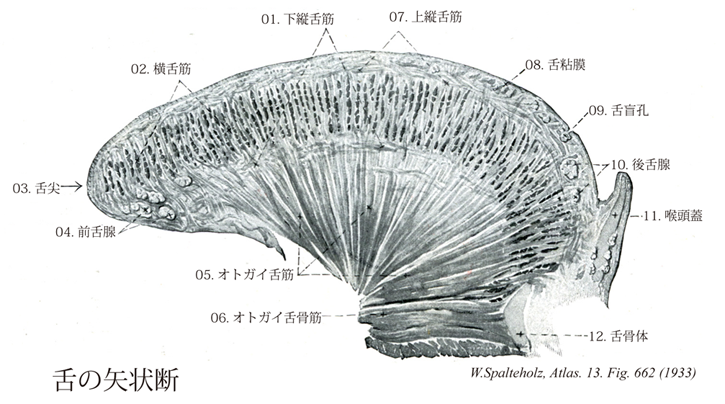Spalteholz HANDATLAS DER ANATOMIE DES MENSCHEN VON WERNER SPALTEHOLZ
メニューは解剖学(TA)にリンクしてあります。図の番号をクリックすると下記の説明へ、右側の用語をクリックすると解剖学(TA)にジャンプします。
662


- 662_00【Tongue舌;シタ Lingua】
→(舌は筋がよく発達した器官で、舌の前方の大部分は舌体、舌の前端部を舌尖、舌の後部を舌根という。また舌の上面を舌背といい、その正中線に舌正中溝があり、舌体と舌根との境界にはV字形の分界溝がある。分界溝の中央には舌背孔とよばれる陥凹があり、これは胎生期に、ここから甲状腺の原基が陥入したため、甲状腺と連なっていた甲状舌管のなごりである。舌の外側縁を舌縁といい、舌の下面正中線には口腔粘膜との間に舌小帯とよばれる粘膜ヒダがあり、舌の下面で、舌根両側から舌尖に向かう軟らかい鋸状の釆状ヒダとよばれる粘膜ヒダがる。舌の表面は舌粘膜でおおわれ、その深層にある舌筋と固く結合している。舌体の粘膜は舌乳頭とよばれる乳頭が非常に発達しており、舌乳頭は糸状乳頭、円錐乳頭、茸状乳頭、葉状乳頭、有郭乳頭に区別されている。舌根には舌乳頭がなく、多数の舌小胞とよばれる小丘状の高まりがみられる。舌小胞はリンパ小節の集団によって構成されており、これらの舌小胞を総称して舌扁桃とよばれている。舌体では舌粘膜が強靭な舌腱膜とよばれる密な結合組織で粘膜下の筋と固く結合しており、舌の正中面では舌腱膜に連続して密な結合組織が中隔をなしており、これを舌中隔とよんでいる。味覚器官をもち、咀嚼、燕下、および構音を助ける。)
- 662_01【Inferior longitudinal muscle of tongue下縦舌筋;深縦舌筋 Musculus longitudinalis inferior; Musculus longitudinalis profundus】 Longitudinally arranged muscle fibers near the inferior surface of the tongue. They pass from the posterior part of tongue to its tip. I: Hypoglossal nerve.
→(有対の縦舌筋は外側を走る舌下神経と、内側の顎舌骨筋との間の舌の下面近くにあり、舌尖のほうへ茎突舌筋により被われる。)
- 662_02【Transverse muscle of tongue横舌筋 Musculus transversus linguae】 Muscle fibers passing transversely between the longitudinal fibers. They arise from the lingual septum and extend into the mucous membrane of the lateral margins of tongue. Together with the vertical muscle of tongue they act to lengthen the tongue. I: Hypoglossal nerve.
→(横舌筋は縦走線維系の間を横走する筋線維。舌中隔から起こり、舌の側縁の粘膜内へいたる。垂直舌筋とともに舌を伸長させる。)
- 662_03【Apex of tongue; Tip of tongue舌尖 Apex linguae】
→(舌体の前端は舌尖といわれる。)
- 662_04Blandin, Gland of; Nuhn, Gland of【Anterior lingual salivary gland; Anterior lingual gland前舌腺 Glandula lingualis apicalis; Glandula lingualis anterior】 Mixed gland in the tip of tongue with several excretory ducts on the inferior surface of tongue.
→(舌の先端に近いところにある。舌尖腺Glandula spicis liguaeともいう。この腺の多くの導管をもって舌尖の下面で、舌小帯の両側に開口している。混合腺である。)
- 662_05【Genioglossus muscleオトガイ舌筋 Musculus genioglossus】 o: Mental spine of mandible, i: Fanlike insertion on the lingual aponeurosis from the tip of tongue to the posterior part of tongue. It draws the tongue anteriorly, i.e., toward the chin. I: Hypoglossal nerve.
→(オトガイ舌筋は、下顎骨のオトガイ棘におけるその起始から舌の筋体の中へ扇状に広がり、舌筋膜に付着する。オトガイ舌筋はオトガイ舌骨筋の上に存在し、対側の同名筋から舌中隔によって内側で隔てられる。オトガイ舌筋は舌骨舌筋によって外側から被われる。)
- 662_06【Geniohyoid muscleオトガイ舌骨筋 Musculus geniohyoideus】 o: Inferior mental spine, i: Body of hyoid bone. Aids the mylohyoid. I: Anterior rami of spinal nerves (C1-C2).
→(オトガイ舌骨筋は顎舌骨筋の上に(口腔の方向)に存在する。オトガイ舌骨筋はオトガイ内面のオトガイ棘から舌骨体まで走る。)
- 662_07【Superior longitudinal muscle of tongue上縦舌筋;浅縦舌筋 Musculus longitudinalis superior; musculus longitudinalis superficialis】 Longitudinal bundle of muscle fibers immediately beneath the mucous membrane. They pass from the tip of tongue to the area near the hyoid bone, o and i: Lingual aponeurosis. I: Hypoglossal nerve.
→(粘膜直下にある縦走束。舌尖から縦走して、舌骨付近までいたる。)
- 662_08【Mucous membrane of tongue舌粘膜 Tunica mucosa linguae】
→(粘膜とは、体内の器官を被う面のうちで、体の外表につながるような面に対して与えられる名称である。そのような粘膜は、上皮epitheliumとこれを直下で支える結合組織(固有層と称する)との2つの基本要素からなる。固有層を作る結合組織の中には、ときに平滑筋層が存在するが、そのさいにはこの平滑筋層のことを粘膜筋板とよぶ。粘膜が表面に粘液を分泌する場合としない場合とがある。)
- 662_09Morand's foramen; Morgagni, Foramen of【Foramen caecum of tongue; Foramen cecum of tongue舌盲孔 Foramen caecum linguae】 Groove located at the tip of the terminal sulcus. Remains of the thyroglossal duct present during embryological development.
→(モルガニ孔とも呼ばれる。①舌盲孔。②胸骨および肋骨と横隔膜との癒合不全。イタリアの解剖学者・病理学者Giovanni Battista Morgani (1682-1771)によって報告された。このほかに、喉頭室(モルガニ洞)にも名を残す。)
- 662_10【Deep posterior lingual gland後舌腺 Glandula radicis linguale; Glandula lingualis posterior】
→(前舌線に対しての総称で①側舌腺Glandula lingualis lateralis(分界溝の前方で舌の外側縁に近く位置する。粘液腺、漿液腺の2種がある。導管は舌の外側縁、あるいは、葉状乳頭の葉間に開いている)、②正中において、盲孔の前方にある腺(粘液腺である)、③有郭乳頭領域にある腺(漿液腺であり、導管は有孔乳頭を囲む堀に注ぐ)。④舌根腺Gladula radicis linguae(舌根にひろがる腺で粘液腺である。導管は舌根の表面に開口している。)をあわせて後舌腺ともいう。)
- 662_11【Epiglottis喉頭蓋 Epiglottis】 Elastic cartilage shaped like a shoehorn.
→(喉頭口の前壁をなし、粘膜におおわれて舌根のところにあり、その概形は喉頭蓋軟骨によってつくられ靴べら様を呈する。喉頭蓋の主な働きは燕下を円滑に行うことである。)
- 662_12【Body of hyoid bone舌骨体;体 Corpus (Ossis hyoidei)】 Anterior segment between the right and left lesser horns.
→(舌骨体は長楕円扁平の骨板で、上縁は鋭く、下縁はやや厚い。前面はややふくれた粗面で舌骨上筋および舌骨下筋群の数個の筋が着く面となる。後面は滑らかでややくぼむ。)
